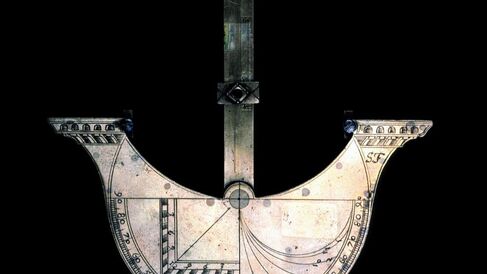A Ship-Shaped Sundial

This instrument (Image 1) is a small sundial shaped like a ship, made in 1620, probably in England. It tells the time by measuring the angle of the Sun above the horizon, and it can be adjusted for use at any time of year and for places at different latitudes. It would have been very useful for merchants and travellers who had to move around England. In fact, some 15th-century dials like this one have lists of towns and their latitudes on them so that it's even easier to set the instrument ready for use.
Armillary spheres are models of the universe. They have been used since antiquity, but very few survive from before the 16th century. The Whipple Museum has one very early example, though dating it accurately is extremely difficult.
Some armillary spheres were used for observing the heavens and some, like this one, were used for teaching and demonstration (Image 1). They are made up of the circles or rings (Latin: armillae) that are used by astronomers to describe the night sky. The names of some of these circles might be familiar to non-astronomers because they are also used to divide up the globe: the arctic and antarctic circles; the Tropics of Cancer and Capricorn, and the equator.
Nicholas Kratzer (b. 1486/7, d. after 1550) was astronomer and astrologer to King Henry VIII. He was also an instrument maker, and is thought to have collaborated with Hans Holbein the Younger (1497/8-1543), one of the most important artists of the 16th century, who included complex instruments in a number of his works. This miniature portrait depicts Kratzer with an armillary sphere; it is one of the earliest known English examples of miniature portraiture.
Medieval origins
Medieval manuscripts call this instrument the navicula (Latin for little ship) because of its ship-shaped design. We don't know for sure when and where the navicula was invented, but John Whethamstede, Abbot of St Albans (d. 1465), says that it was invented by a monk at Glastonbury Abbey. All the medieval naviculas and all the manuscripts about how to make and use them are from England, suggesting that the instrument was invented there.
New name, new design
In the early 15th century a manuscript about the navicula went to Vienna, where it was renamed organum ptolomei. It was studied and redesigned by the famous mathematician Georg von Peurbach (1423-1461), and the new instrument was printed by Regiomontanus in his book Kalendarium in 1476.
Instruments and books
The French mathematician Oronce Fine published a book about sundials in 1560 which included a description of how to make a Regiomontanus dial and a ship-shaped dial, with diagrams showing how the finished instrument should look. Because Fine's instrument is based on the reworked versions of the ship-shaped dial described in manuscripts from German-speaking lands (and not the manuscripts from medieval England) it should probably be called an organum ptolomei (instrument of ptolemy) but Fine just calls it "another universal horizontal dial".
Owned by 'S. F.'
The Whipple Museum's ship-shaped dial is interesting because it is an exact copy of the diagrams in Fine's book (Image 2). So, we can see that an educated English gentleman read Fine's book and commissioned an instrument just like the one in the diagrams. However, we don't know who he was - the initials S. F. are on this instrument, but not his full name.
Catherine Eagleton
Catherine Eagleton, 'A ship-shaped sundial, dated 1620', Explore Whipple Collections, Whipple Museum of the History of Science, University of Cambridge, 2017
